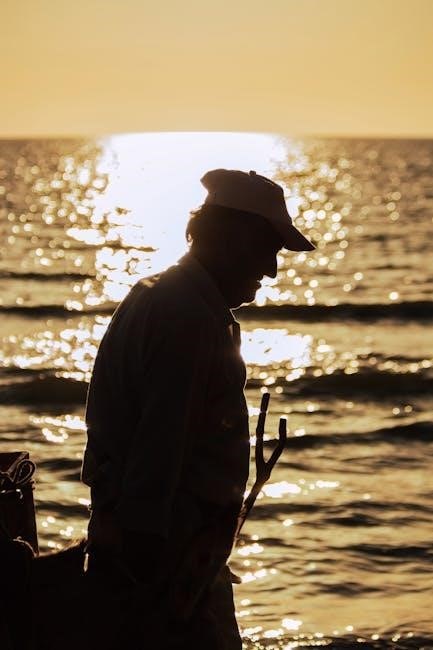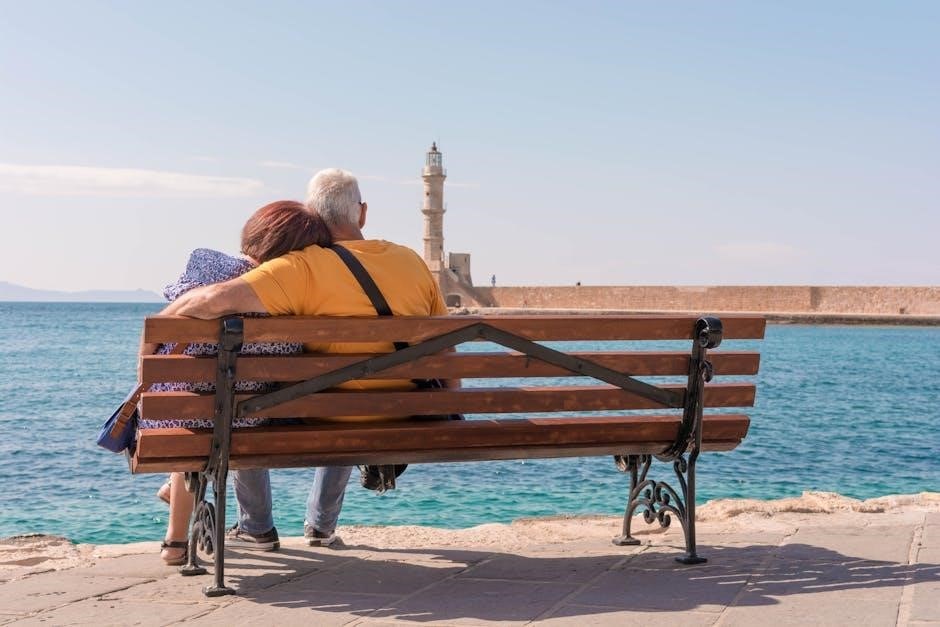Ernest Hemingway’s novella tells the story of Santiago‚ an aging fisherman‚ and his epic battle with a giant marlin‚ exploring themes of perseverance and human struggle.

1.1 Background and Context
The Old Man and the Sea was written by Ernest Hemingway in the early 1950s and published in 1952. Set in Cuba‚ the novella reflects Hemingway’s fascination with the human struggle against nature. The story is deeply rooted in the cultural context of Cuban fishermen and their daily battles with the sea. Hemingway’s personal experiences as a big-game hunter and his admiration for simplicity and courage influenced the narrative. The novella marked a literary comeback for Hemingway‚ solidifying his reputation as a master of concise storytelling. Its themes of resilience and redemption resonate universally‚ making it a timeless classic.
- Published in 1952‚ it revitalized Hemingway’s career.
- Set in Cuba‚ reflecting Hemingway’s love for the sea and its people.
- Inspired by Hemingway’s own experiences and philosophical views.
1.2 Ernest Hemingway’s Writing Style
Ernest Hemingway’s writing in The Old Man and the Sea is characterized by his signature simplicity‚ clarity‚ and directness. He employs the “Iceberg Theory‚” where deeper meanings lie beneath the surface of concise prose. Hemingway avoids elaborate descriptions‚ instead using precise‚ evocative language to convey emotion and themes. His focus on action and dialogue creates a sense of immediacy‚ while understated emotional depth draws readers into Santiago’s journey. The novella’s spare‚ rhythmic style mirrors the simplicity of the old man’s life‚ emphasizing universal themes like courage and resilience. Hemingway’s approach makes the story both accessible and profound.
1.3 The Novella’s Importance in Literary History
The Old Man and the Sea holds a significant place in literary history as Ernest Hemingway’s revitalizing work after a decade of creative silence. Published in 1952‚ it earned Hemingway the Pulitzer Prize in 1953 and was a key factor in his Nobel Prize in Literature in 1954. The novella exemplifies Hemingway’s minimalist style and explores universal themes of perseverance and human struggle. Its concise yet profound narrative influenced 20th-century literature‚ showcasing how simplicity and depth can coexist. It remains a timeless classic‚ celebrated for its emotional resonance and philosophical depth‚ cementing Hemingway’s legacy as a literary giant.

Plot Summary of “The Old Man and the Sea”
Santiago‚ a determined old fisherman‚ battles a giant marlin‚ faces relentless sharks‚ and loses his prize‚ but finds personal victory in his resilience and unbroken will.
2.1 Setting: The Coastal Town and the Sea
The story unfolds in a small coastal town and the vast‚ unpredictable sea. The town represents community and support‚ while the sea symbolizes isolation and nature’s power. Santiago’s journey begins in the town‚ where he interacts with Manolin‚ then moves to the open water‚ emphasizing his solitude. The sea’s beauty and brutality serve as a backdrop for Santiago’s struggle‚ showcasing both its life-giving and destructive forces. The setting reinforces the themes of human resilience and the unyielding natural world‚ creating a vivid contrast between land and sea.
2.2 The Old Man’s Initial Situation
Santiago‚ an aging fisherman‚ faces a prolonged period of bad luck‚ having gone 84 days without catching fish. His village views him as unlucky‚ and the young boy Manolin is discouraged from fishing with him. Despite this‚ Santiago remains determined and prepares for another solo voyage‚ determined to break his streak. His physical condition reflects his age‚ with hands bearing scars from years of labor‚ yet he retains a deep connection to the sea and its rhythms. His initial situation sets the stage for a journey of redemption and personal triumph against overwhelming odds.
2.3 Santiago’s Journey to the Sea
Santiago begins his journey by gathering his fishing supplies and preparing his boat with the help of Manolin. The two share a quiet moment over coffee‚ reflecting on Santiago’s determination. Manolin fetches sardines for bait‚ wishing Santiago luck before returning home. Undeterred by his recent failures‚ Santiago sets sail alone‚ venturing far into the Gulf Stream. His journey symbolizes both his physical and emotional quest‚ driven by a deep connection to the sea and an unyielding spirit. The vast‚ lonely expanse of the ocean awaits‚ setting the stage for his monumental challenge.
2.4 The Battle with the Giant Marlin
Santiago’s journey takes a dramatic turn when he hooks a colossal marlin‚ initiating an arduous battle that spans several days. Despite the marlin’s immense strength‚ Santiago’s unwavering resolve drives him forward. The struggle pushes his physical limits‚ testing his endurance and willpower. Throughout the ordeal‚ Santiago reflects on his life‚ emphasizing his connection to nature and the marlin as a symbol of his unrelenting spirit. The epic confrontation between man and nature captivates readers‚ illustrating themes of perseverance and the human condition in the face of overwhelming adversity.
2.5 The Struggle with Sharks
After Santiago harpoons the giant marlin‚ his victory is short-lived‚ as a swarm of sharks‚ attracted by the marlin’s blood‚ begin devouring the carcass. Despite his efforts to fend them off‚ the sharks relentlessly consume the marlin‚ leaving only its skeletal remains. This struggle symbolizes the inevitability of destruction and the harsh realities of nature. Santiago‚ though defeated in preserving the marlin‚ finds a strange sense of acceptance in the cycle of life and death at sea. The sharks represent the uncontrollable forces of nature that even the most determined individuals cannot overcome.
2.6 The Old Man’s Return and Acceptance
Santiago returns to shore exhausted‚ bearing only the marlin’s skeletal remains. Though defeated in securing the marlin’s flesh‚ he accepts his fate with quiet dignity. The villagers marvel at the massive skeleton‚ a testament to Santiago’s endurance. Santiago‚ though physically broken‚ finds solace in the journey itself‚ recognizing that true triumph lies in the courage to persevere. His acceptance of life’s challenges and the inevitable cycle of victory and loss underscores the novella’s themes of resilience and the human spirit’s capacity to find meaning in adversity.

Major Characters in the Novella
The novella centers around Santiago‚ an aging fisherman‚ and Manolin‚ a devoted young boy. The marlin symbolizes Santiago’s struggle‚ while sharks represent inevitable destruction.
3.1 Santiago: The Protagonist
Santiago is the aging fisherman and protagonist‚ embodying resilience and determination. After 84 days without a catch‚ he ventures into the sea‚ driven by perseverance and personal triumph. His weathered hands and physical exhaustion reflect his lifelong struggle with nature. Despite his solitude‚ Santiago connects deeply with the sea‚ viewing it as both a source of life and a relentless challenger. His journey with the giant marlin symbolizes his battle against despair and his quest for redemption. Ultimately‚ Santiago’s acceptance of defeat and the cycle of life underscores his unyielding spirit and profound humanity.
3.2 Manolin: The Young Boy’s Role
Manolin is a young boy who deeply admires Santiago and sees him as a mentor. Despite Santiago’s long streak of bad luck‚ Manolin believes in his ability to catch fish and often assists him‚ showing loyalty and respect. Their bond highlights the connection between generations and the importance of perseverance. Manolin’s presence emphasizes Santiago’s humanity and the emotional support he receives‚ contrasting with his solitary journey. The boy’s belief in Santiago underscores the themes of hope and camaraderie‚ making him a vital character in the narrative.
3.3 The Marlin: Symbolism and Significance
The giant marlin represents Santiago’s ultimate challenge and dream‚ embodying his unyielding spirit and pursuit of greatness. It symbolizes the struggle between humanity and nature‚ where the marlin’s grandeur reflects the vast‚ unrelenting power of the sea. The marlin also signifies personal triumph and redemption‚ as Santiago’s journey to catch it is a testament to his resilience. Despite the marlin’s eventual destruction by sharks‚ its presence underscores Santiago’s dignity and perseverance‚ leaving a lasting impact on his character and the story’s themes of struggle and acceptance.
3.4 The Sharks: Representing Destruction
The sharks symbolize the destructive forces of nature and the inevitable decay of human achievement. They appear after Santiago’s triumph of catching the marlin‚ relentlessly devouring the fish. This destruction underscores the harsh reality that success is often fleeting. The sharks’ brutal efficiency contrasts Santiago’s dignity and perseverance. Their presence teaches Santiago to accept loss gracefully‚ emphasizing that true victory lies in the struggle‚ not the outcome. This theme highlights the novella’s exploration of human resilience against uncontrollable natural forces‚ reinforcing Santiago’s acceptance of his fate and the enduring spirit of humanity‚ ultimately enriching the narrative’s profound lessons on life and perseverance.

Themes Explored in the Novella
The novella explores themes of perseverance‚ human struggle against nature‚ and redemption‚ highlighting Santiago’s journey as a universal metaphor for life’s challenges and personal triumphs.
4.1 Perseverance and Resilience
Santiago embodies perseverance and resilience as he faces relentless challenges at sea. Despite 84 days without catching fish‚ he ventures out again‚ driven by determination. His battle with the giant marlin tests his physical and mental endurance‚ yet he persists‚ refusing to surrender. Even after the marlin is devoured by sharks‚ Santiago returns home with dignity‚ symbolizing resilience. His journey reflects the human spirit’s capacity to endure suffering and remain unbroken‚ inspiring hope and admiration. Santiago’s perseverance is not just about catching fish but about overcoming life’s adversities with unwavering resolve.
4.2 The Human Struggle Against Nature
The novella vividly portrays the human struggle against nature through Santiago’s arduous journey. The old man battles the vast‚ indifferent sea‚ symbolizing humanity’s eternal conflict with the natural world. His quest to catch the giant marlin represents the futile yet noble effort to conquer nature’s power. Despite his ultimate defeat‚ as sharks devour the marlin‚ Santiago’s struggle embodies respect for nature’s majesty and the unyielding human spirit. The novella highlights the delicate balance between human determination and nature’s overwhelming force‚ leaving a profound reflection on human existence and the natural world.
4.3 Redemption and Personal Triumph
Santiago’s journey embodies redemption and personal triumph‚ transcending material success. Despite returning with only a marlin skeleton‚ he achieves a profound sense of victory through his perseverance. The old man’s courage and determination in the face of overwhelming odds redefine success‚ emphasizing inner strength over external rewards. His struggle becomes a testament to the human spirit‚ proving that true triumph lies in the effort‚ not the outcome. This theme resonates deeply‚ highlighting that redemption is often found in the courage to endure and the dignity of pursuit‚ rather than the achievement itself.

Symbolism in “The Old Man and the Sea”
The novella is rich in symbolism‚ with the marlin representing noble struggle‚ sharks embodying destruction‚ and Santiago’s journey symbolizing the universal human quest for meaning and perseverance.

5.1 The Marlin as a Symbol
The giant marlin in Ernest Hemingway’s novella symbolizes Santiago’s ultimate challenge and his unwavering dedication to his craft. The marlin’s immense size and strength represent the magnitude of Santiago’s struggle‚ embodying the ideal of a noble and worthy adversary. Its beauty and grace contrast with the harsh reality of the sea‚ highlighting the themes of perseverance and respect for nature; The marlin also symbolizes Santiago’s quest for redemption‚ as catching it becomes his defining moment‚ proving his worth despite his advanced age and previous failures. The marlin’s eventual death serves as a poignant reminder of the transience of victory and the inevitability of loss.
5.2 The Sharks as Destroyers
In The Old Man and the Sea‚ the sharks symbolize destructive forces beyond human control. They relentlessly attack Santiago’s prized marlin‚ stripping it of its flesh and leaving only bones. The sharks represent the inevitability of loss and the harshness of nature‚ which cannot be tamed or defeated. Despite Santiago’s courage and effort‚ the sharks embody the reality that some struggles are futile. Their presence underscores the theme of man versus nature‚ where even the greatest triumphs are subject to destruction. The sharks serve as a reminder of life’s impermanence and the unavoidable forces that shape human destiny.
5.3 Santiago’s Hands: A Symbol of Endurance
Santiago’s hands in The Old Man and the Sea are symbols of endurance and resilience. They are scarred‚ worn‚ and weathered‚ reflecting years of relentless toil at sea. Despite their physical toll‚ his hands remain strong and capable‚ embodying his unyielding spirit. They symbolize his dedication to his craft and his refusal to surrender‚ even in the face of overwhelming adversity. Santiago’s hands are not just tools but a testament to his perseverance‚ highlighting the human capacity to endure suffering and persist in the pursuit of meaning‚ even when the odds seem insurmountable.

Hemingway’s Writing Style in the Novella
Hemingway’s writing style in The Old Man and the Sea is characterized by simplicity‚ clarity‚ and understatement‚ reflecting his Iceberg Theory of implicit emotion and depth.
6.1 The Iceberg Theory and Understated Emotion
Hemingway’s Iceberg Theory is evident in The Old Man and the Sea‚ where much of the narrative’s emotional depth lies beneath the surface. Santiago’s thoughts and feelings are rarely explicitly stated‚ leaving readers to infer his inner world through subtle cues. This understatement creates a powerful‚ minimalist narrative that resonates deeply. The old man’s quiet determination and resilience are conveyed through sparse dialogue and actions‚ allowing the reader to fill in the emotional gaps. This technique enhances the novella’s universality‚ making Santiago’s struggle and triumph relatable across cultures and generations.
6.2 Use of Simple and Direct Language
Hemingway’s prose in The Old Man and the Sea is characterized by simplicity and clarity. He avoids elaborate descriptions‚ instead using direct‚ concise language to convey the story. This style mirrors Santiago’s straightforward‚ unassuming nature‚ making the narrative feel authentic and accessible. The simplicity emphasizes the universality of the themes‚ allowing readers to connect deeply with Santiago’s journey. Hemingway’s directness also heightens the emotional impact‚ as the lack of embellishment underscores the raw‚ unfiltered essence of the old man’s struggle and resilience.

The Significance of the Novella
The novella’s significance lies in its universal themes and Hemingway’s triumphant return to prominence. It revitalized his career‚ earned a Pulitzer‚ and remains a timeless tale of perseverance and the human struggle against nature‚ resonating globally.
7.1 Hemingway’s Career Revival
The Old Man and the Sea marked a pivotal moment in Ernest Hemingway’s career‚ revitalizing his reputation after a decade of critical decline. The novella‚ with its concise yet profound storytelling‚ showcased Hemingway’s mastery of simplicity and depth. It earned him the Pulitzer Prize in 1953‚ solidifying his status as a literary giant. The book’s success also set the stage for him to receive the Nobel Prize in Literature in 1954. This work not only restored Hemingway’s acclaim but also reminded readers of his unique ability to explore human resilience and nature’s grandeur through minimalistic prose.
7.2 Universal Themes and Relatability

The Old Man and the Sea captivates readers with its universal themes of perseverance‚ hope‚ and the human struggle against nature. Santiago’s journey resonates across cultures‚ as it reflects the timeless quest for meaning and redemption. The novella’s simplicity and depth allow readers to connect with Santiago’s determination and acceptance‚ making it a relatable story for anyone facing adversity. Its exploration of human resilience and the inevitable cycle of life and death ensures its enduring appeal‚ transcending time and cultural boundaries.
Santiago’s journey embodies perseverance and acceptance‚ leaving readers with a profound reflection on life’s struggles and the enduring human spirit. The novella remains timeless.
8.1 Final Thoughts on Santiago’s Journey
Santiago’s journey is a profound exploration of perseverance‚ resilience‚ and acceptance. Despite his physical exhaustion and the loss of the marlin‚ he finds dignity in his struggle. The old man’s unwavering determination reflects the human spirit’s capacity to endure adversity. His return to shore‚ though without the marlin‚ signifies a deeper triumph—a triumph of spirit and acceptance. Santiago’s story transcends mere fishing; it becomes a universal metaphor for life’s challenges and the quiet courage needed to face them. His journey leaves readers contemplating the essence of struggle‚ loss‚ and the unyielding will to persist.
8.2 The Timeless Appeal of the Novella
The timeless appeal of The Old Man and the Sea lies in its universal themes and simplicity. Hemingway’s concise prose makes the story accessible‚ yet its depth invites reflection. The novella’s exploration of perseverance‚ nature‚ and human struggle resonates across cultures and generations. Santiago’s journey symbolizes life’s inherent challenges‚ offering readers a powerful metaphor for personal resilience. Its enduring popularity stems from its ability to evoke empathy and inspire contemplation‚ ensuring its place as a classic in world literature.